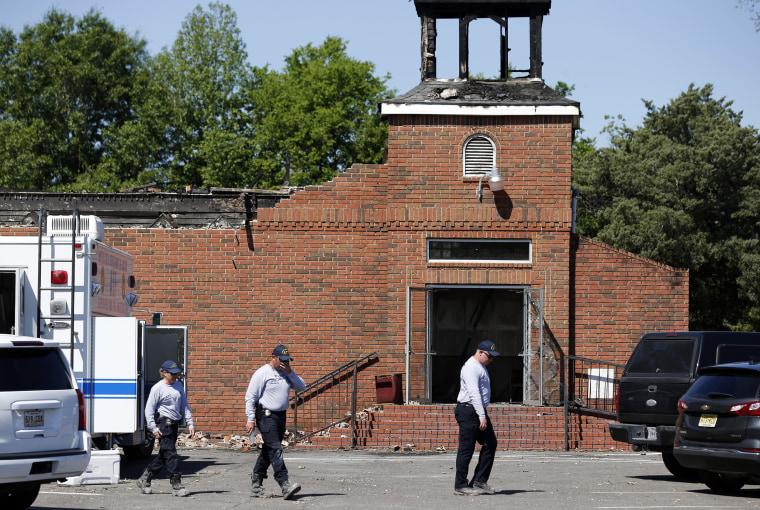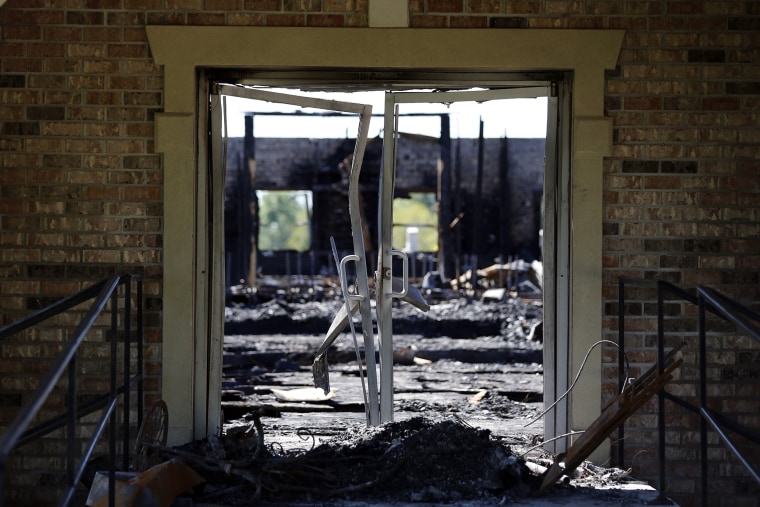When Louisiana State Fire Marshal Butch Browning announced an arrest this week in the "suspicious" torching of three historically black churches, he sought to allay fears: "I will say the threat is now gone."
But for some churchgoers and black residents in St. Landry Parish and across south central Louisiana, the fear remains that it could happen again.
And there's a good reason.
Historic racial violence and bloodshed in Opelousas, where two of the churches are, and visible Ku Klux Klan activity in the surrounding area about 20 years ago remain painful reminders of intolerance and bigotry that some worry still lurks on the fringes.
"We are grateful that law enforcement worked very rapidly," said John Milton, the religious affairs chairman of the NAACP chapter in Lafayette, about 20 miles from the churches. "But we believe that it's much more deeper than this case. Because of the past history of black church burnings, the bottom line is we know there is a substantial connection between race and this event, and this is not an isolated incident."
Federal investigators stressed at a news conference Thursday that they had not yet determined a motive for the burnings or whether the attacks constitute a hate crime.
Holden Matthews, 21, was charged with three counts of arson for allegedly setting fire to the three churches in St. Landry Parish over 10 days beginning March 26. Officials said that Matthews, who is white and the son of a St. Landry Parish sheriff's deputy, appeared to be a fan of black metal music, a subgenre of heavy metal that has been associated with white nationalist ideology and church burnings in Norway.
An affidavit filed in the case said authorities linked Matthews to the fires with the help of surveillance video, cellphone tower data and the purchase of a gas can and other materials from a Walmart.
"When people feel threatened, they will lash out and strike first," Milton said.
St. Landry Parish, brimming with Creole culture and a population of more than 83,000, is about 56 percent white and 42 percent black, census data shows.
Rick A. Swanson, a professor and civil rights researcher at the University of Louisiana at Lafayette, said a pattern of violence against black people and black churches in the area has roots dating to Reconstruction after the Civil War.
Most notably, in 1868, black families in St. Landry were harassed and killed by vigilante white men upset over the newfound voting influence of freed African Americans.
Some estimates at the time put the number killed at 200, although that figure has been disputed, according to reports on what is referred to as the Opelousas massacre, which set the stage for lynchings and other racial strife throughout the state.
"There's a very intense history that can't be ignored," Swanson said.

As the cornerstone for black communities across the South, churches were threatened, burned and bombed during the civil rights movement.
Louisiana was not immune from the wave of church burnings in the 1990s that led President Bill Clinton to form a National Church Arson Task Force to investigate the causes. Five churches that were damaged or destroyed were in Louisiana, where David Duke, a prominent white supremacist, had won a state House race a few years earlier.
In the Lafayette area in the mid-'90s, a local public-access cable TV channel allowed a Klan leader to host his own show, "The Klan in Akadiana" — a play on the state's Acadiana region celebrated as the heart of Cajun country.
News reports in 1996 described the show, which attracted "a few thousand die-hard cable subscribers," as "an hour of hooded robes, Confederate flags and burning crosses."
The local NAACP, however, challenged how the show's host, an imperial wizard of the Knights of the White Kamellia, allowed several guests to wear masks — violating a 1924 state statute that said mask-wearing was prohibited in public, except for events such as Halloween and Mardi Gras.
After attracting national attention, the show was off the air the following year.
Locally, Swanson said, there hasn't been a blatant peddling of white supremacist ideology in recent memory, although hate groups have been on the rise nationally over the past four years.
There are plans Saturday for local NAACP members and faith leaders to come together in Opelousas to talk about restoring their sense of community, Milton said.
With this Palm Sunday marking the beginning of Holy Week, worshippers at the three affected churches — St. Mary Baptist Church in Port Barre, the Greater Union Baptist Church and Mount Pleasant Baptist Church, both in Opelousas — have found other places to hold services.
Celina Richard, who belongs to the Greater Union Baptist Church, said she doesn't necessarily need to know whether hate motivated someone to target her church — where she was baptized at 16, had married at 21 and buried her parents last year.
But the destruction of her church, which has about 100 members, has shattered her feeling of security. Congregants must rebuild the burnt ruins now considered a crime scene.
"This has been a very trying time, and at the same time, you have mixed emotions," said Richard, a retired school teacher. "You're so happy somebody has been caught, but they had the audacity to take something from you. It's unsettling."


